The Douglas-fir Needle Midge (Contarinia pseudotsugae) is host specific to only Douglas-firs. The insect infests needles & symptoms create a twisted distortion having yellow banding discolorations with swollen areas. Inside the swollen areas of the needle are fly larvae (maggots) of the Douglas-fir needle midge (DFNM). Typically scouting observations for needle infestations can begin to be easily observed during mid-summer. At maturity, the swollen areas turn brown or purple. The maggot is less than 5.0 mm in size & later in the season, the larvae can be exposed by opening the necrotic swollen area using a sewing needle. Symptoms can mimic those caused by Cooley spruce gall adelgids. The needle cast diseases (Swiss or Rhabdocline) can also sometimes mimic the symptoms if the infestation is serious enough to cause thinning from excessive needle drop.
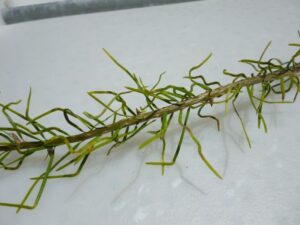
Late season symptoms from a severe infestation of the Douglas-fir Needle Midge. The resulting needle distortion & twisting can sometimes become extreme. (Photo Credit: Steven K. Rettke, Rutgers Coop. Ext.)
The DFNM was discovered to be an increasing problem in southern NJ more than 15 years ago. Previously the DFNM within the landscape had been completely off the radar. Infestations are limited to only Douglas-firs & had been primarily associated with Christmas tree production farms. Introduction into the landscape has unintentionally been caused by ball & burlap purchases that are initially used as indoor Christmas trees & then transplanted outdoors.
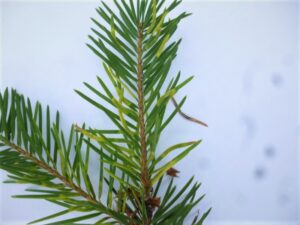
Early summer symptoms from a moderate infestation of Douglas-fir Needle Midge. The needles will initially show light-yellow banding & have slight distortions. (Photo Credit: Steven K. Rettke, Rutgers Coop. Ext.)
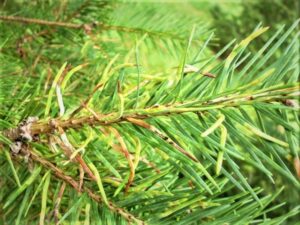
Late summer symptoms from a moderately-high infestation of Douglas-fir Needle Midge. Needles will become darker in color with greater distortions. (Photo Credit: Steven K. Rettke, Rutgers Coop. Ext.)
After dropping to the ground in November/December the larvae will overwinter in the soil under the tree they infested during the season. They pupate in early spring as the soil temperatures rise and emerge as adults in late April & continue into the weeks of May. These 1/8th size gnat-like flies can congregate in mating clouds & then begin to lay eggs in the new needle growth. The growing degree days (GDD) for adult emergence have been estimated to occur during the 200-400 GDD range. Some of the control sprays targeting adults include pyrethroids & acephate.
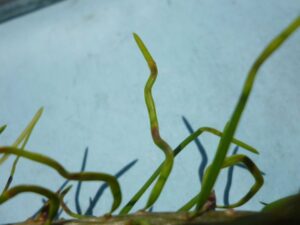
Close-up of a single Douglas-fir needle shows symptoms of at least two DFNM maggots feeding within. Needle twisting has become severe. (Photo Credit: Steven K. Rettke, Rutgers Coop. Ext.)

During late fall, mature DFNM larvae will emerge from needles & drop to the ground to overwinter in soil under trees. (Photo Credit: Tracy Olsen, PA Dept. of Ag.)
The best treatment window against the DFNM can also be determined with the placement of traps under trees to detect emerging adults. In most locations, traps should ideally be in place by late April if not earlier. Detection traps can be made with a plastic recycling bin or wax-coated cardboard box. Cut a hole in the side of the box to fit a clear empty jar into the opening. Place a dry, crumpled paper towel in the jar to absorb moisture. The box should be upside-down on the ground with heavy rocks securing it in place. When Midges emerge from the ground they are attracted to light coming from the hole in the box and become trapped in the jar. Control sprays should be applied to the trees within one week of the first catch. An additional spray should be made after approximately 10 days.
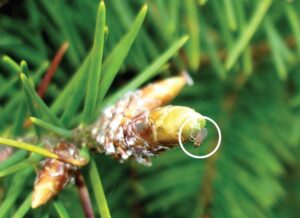
Douglas-fir Needle Midge adults emerge from the soil in mid-spring after overwintering under tree. Control treatments are targeted toward adult midges as they attempt to lay eggs on needles of growing stems. (Photo Credit: Tracey Olsen, PA Dept. of Ag.)
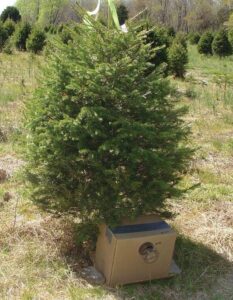
Hand-made trap designed to detect adult emergence of Douglas-fir Needle Midge. (Photo Credit: Sandy Gardosik, PA Dept. of Ag.)
Reference: Rutgers Plant & Pest Advisory, “The Douglas-fir Needle Midge” (August 2005), by Jenny Carleo, Former Rutgers Ag. Agent of Cape May Co.

